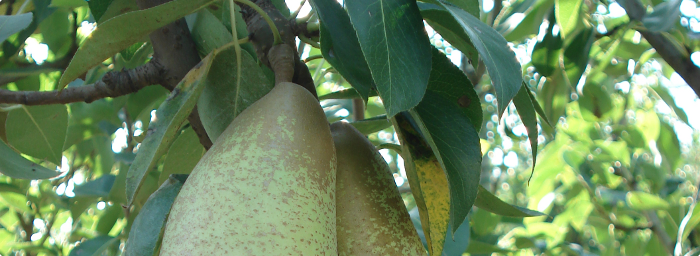Our Products
The Pears
The pear tree has very deep roots, high up to twenty meters, with nearly oval leaves and flowers gathered in groups, which develop from buds at the end of twigs bearing course of 2-3 years. Pears take shape, size, color and taste very different depending on the cultivar: There are over 5,000 varieties of pears in the world.
The fruit was known and eaten since the Stone Age. The progenitor of modern pear comes from south-eastern Europe and those from western Asia.
» Imperatore Alessandro or Kaiser
» Nutritional quality and storage of pears
Varieties of pears
The pears can be found throughout the year because the different varieties ripen at different times. The following describes the most common varieties.
- English William cultivars (also called Bartlett). It is the most important for export and for industrial uses. Emilia Romagna is the most productive region (70%) while the Veneto region accounts for 10% of national production.
Cultivar is the derivation of William Max Red Bartlett (also known as William Ross). The flesh is whitish, very juicy, sweet-sour, with characteristic muscat aroma, fine, compact. In addition to direct consumption, William pears are widely used by industry for the preparation of syrups and juices. The fruits are harvested in mid-August, and conservation status under the cold for 3 to 4 months. - Passa Crassana. French cultivar half of 1800, until recently, held the record production. The fruit is large, the peel is green, yellow at maturity, often somewhat rusty in the area of the stalk. The red variety is rust-colored on almost all of the skin. The pulp is white, grainy, good flavor. The fruits are harvested in October and have excellent aging potential and resistance.
- Decana del Comizio. French cultivar, is especially popular in Emilia Romagna (80th%) and Veneto (12%). The fruit is large, rusty, the skin is yellow-green, smooth, dotted with numerous small lenticels. The pulp is white, fine, melting, juicy, sweet-tart and aromatic. The fruits are delicate in handling but very long-lasting. Gathered in the first / second week of September and can be stored in a refrigerator until December / January.
- Conference. English cultivar of the last century. Began to spread in Italy around 1950. It is grown mainly in Emilia Romagna and Veneto, from which respectively 70% and 15% of national production. The fruit is medium in size, the skin is greenish-yellow bronze (or rust) with pronounced lenticels at maturity. The flesh is yellowish white, melting, very juicy, sweet and aromatic, slightly tart, taste very pleasant. Conference pears, harvested at an early stage of maturation (third week of August-early September) can be stored in a refrigerator until December / January.
- Abate Fétel. French cultivars of last century. Its production is derived mainly from the Emilia Romagna (80%) and Veneto (10%). The fruit is large, the skin is yellowish, suffused with the unusual red. The pulp is white, melting, very juicy, sweet and aromatic. The fruits, very resistant and long-lasting, are collected in the first half of September.
- Imperatore Alessandro or Kaiser. French cultivars of last century. The regions where it is most widespread are Emilia Romagna (60%) and Veneto (15%). The fruit is large, the skin is rust on bronze and yellow background with numerous lenticels apparent. The flesh is yellowish white, firm, just gritty, juicy, sweet-tart, aromatic. The fruits are harvested in the second decade of September and have some aging potential until December when refrigerated.
Nutritional quality and storage of pears
The pears bruise easily, so you must handle with care, it should buy them hard and to mature at home, during consumption. The pears are in fact very well preserved in the refrigerator and mature better when collected. To accelerate the ripening process is enough to put the pears in a brown paper bag at room temperature in a period of 2 to 5 days will be ready to eat.
During the ripening pears produce ethylene, a natural gas that is also a natural hormone for aging: a packet is not closed keeps the ethylene close to the fruit and helps the aging, also not likely to affect other foods (such as leafy vegetables ) sensitive to ethylene. Paper bags help to prevent wilting him to keep the moisture produced by the fruit during ripening. Even the plastic bags are also in order, but accelerates the process too because they increase the humidity in a consistent manner and may cause rot.
Pears are low in calories (30-35 kcal per 100 g), are rich in insoluble fiber and are not particularly interesting for the vitamin content. Instead, they contain a fair amount of potassium. They have a fairly high index of satiety and therefore are indicated in snacks or to close a little satiating meal.






